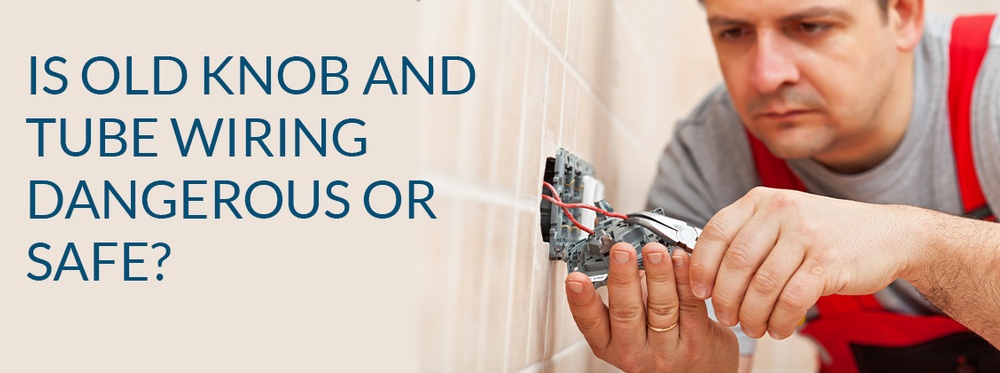Is Old Knob And Tube Wiring Dangerous Or Safe?

The old-fashioned electrical system known as knob and tube wiring system can be dangerous in several ways. As a company that provides Niagara home inspections, we uncover a lot of older homes with this type of wiring. If you’ve just learned that knob and tube wiring are installed in your home or in a house you’re about to purchase, find out the information you must know to protect yourself and your family.
Here is our in-depth guide to the little-known electrical hazards of knob and tube wiring.
What Is Knob and Tube Wiring?
Knob and tube electrical wiring is a type of electric wiring which is found in many old Niagara homes. Popular from the late 19th through the mid 20th century, knob and tube systems are made up of two long copper wires (usually 12 gauge) insulated with a rubberized cloth. To protect against chafing, these insulated wires were wound around white ceramic knobs at important connection points. Would you like to know whether your home has knob and tube wiring? Just look for these ceramic knobs — you will spot them nailed to exposed joists.
What Are the Dangers of Knob and Tube Wiring?
While it’s not against the law to have a knob and tube system in your home in Canada today, this obsolete wiring method is a potential safety hazard in one or more ways, including:
Fire Hazard
Old knob and tube wiring can be a fire hazard. The wiring’s rubber-based insulation, in many cases, has not held up well over time. Exposure to heat and air causes the rubber to become brittle and crack flake, or char. As a result, the damaged insulation can no longer protect the wire inside, making your home a fire risk.
No Ground Wiring
Because knob and tube is a two-wire system that does not contain ground wiring, it is incompatible with your modern three-prong appliances. Without grounding, knob and tube can damage your electronics. Even more severe, it exposes your household member to the risk of electrical shock or worse, electrocution.
Moisture Issues
Knob and tube electrical wiring is not rated as moisture safe. Therefore, it is a shock hazard when used in “wet” environments, such as kitchens, bathrooms, laundry rooms, wet bars, and outdoors.
DIY Modifications
Would-be home electricians tend to love fiddling with knob and tube — often with disastrous consequences. In addition, its easy accessibility leads some homeowners to attempt DIY modifications or worse, hiding open junctions behind walls that usually don’t work out so well, making it even more dangerous to have in your house.
Hidden By Insulation
In recent years, we Canadians have become diligent about insulating our homes. That is excellent for improving energy efficiency… but very bad news for residences equipped with knob and tubing wiring! You see, this type of wiring was designed to dissipate its heat into the surrounding air. Unfortunately, added insulation interferes with this process, allowing the wires to grow alarmingly hot… and potentially catch fire.
Can’t Handle Today’s Demand of Electricity
With its abundance of appliances and sophisticated electronic gadgets, today’s high-tech lifestyle puts a heavy demand on home electrical systems. Unfortunately, knob and tube wiring — which was installed well before the invention of home computers, hot tubs, and microwaves — just cannot handle the power requirements of all our 21st-century devices. The resultant overload puts your home at risk of a devastating electrical fire.
Insurance Problems
Insurance companies tend to be reluctant to insure homes wired with knob and tube, and often not at all. And no wonder… they don’t want to take on the greater risk of accidents and electrical fires. So even if you can get homeowners insurance (usually following inspection of the wiring by a qualified professional electrician), you are likely to be hit with much higher premiums than your neighbour who has a safe, upgraded electrical system.
Can Knob and Tube Wiring Be Fixed?
Yes, sometimes knob and tube can be repaired so that it is functional and safe — for the time being. However, knob and tube wiring repair is a complex and expensive method of fixing up a very outdated system. Usually, you’ll find it preferable to have your home rewired instead. This will ensure that your electrical system is fully code-compliant, up to date, and safe… ready to handle all your sensitive electronics and household appliances.
What does rewiring your house involve? First, you’ll have to have all the old wiring removed and replaced with modern wiring, connections, and other components. This is skilled work that should be done only by a reliable licensed electrician who has previous experience with knob and tube wiring replacement.
We’ll Make Sure Your Wiring Is Safe
Are you worried about the possibility of knob and tube wiring in your next home purchase? We offer Niagara Region Home Inspections to inspect that your purchase is safe. Then contact Elementary Property Inspections for a complete home inspection 289-686-9482.